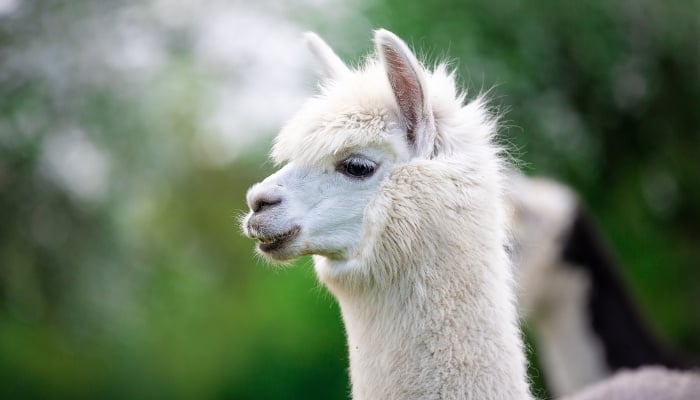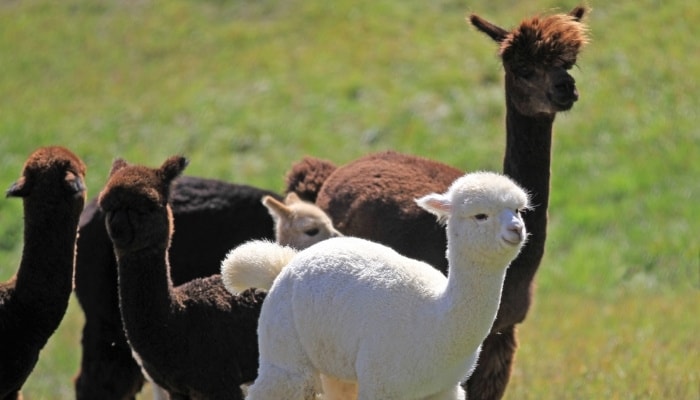Alpacas are petite and adorable creatures, similar to lamas in many ways. They are commonly raised for their extremely valuable wool.
Handling alpacas means you may need to get into spitting distance of them… literally.
Do alpacas spit? Alpacas are known for spitting at one another, especially in the case of females spitting at males that are pestering them. These pack animals also spit at each other, and even their handlers, out of self-defense instincts, food dominance/competition, and as a way to communicate.
Read on below and learn everything you need to know about alpacas spitting, including why they do it, warning signs, and how to avoid it!
Alpaca Spitting
Although alpacas are known for their ability to spit and their willingness to use spitting as a means of communication, that is not to say that they will always do so.
Alpacas are much more likely to spit at one another than they are to spit at their caretakers.
That’s why you need to understand the why behind alpaca spitting.
Why Do Alpacas Spit?
There are several predominant reasons for alpaca spitting: self-defense, food competition, and as a means of communication.
In the following sections we take an in-depth dive into all of the whys and whens regarding alpaca spitting:
1. To Establish Dominance Within the Herd
Alpacas are pack animals, though they do enjoy a bit of private space. When one alpaca lacks respect for another alpaca’s space, it is likely to be spit on by its herd-mate.
This type of spitting is a means for establishing dominance and as a territorial defensive measure.
2. Female Fending Off Males
Sometimes male alpacas can be really persistent with their attempts to woo and mate with female alpacas.
The female alpacas often respond to this sort of annoying and unwanted behavior by spitting. After getting hit with a few mean spitballs, the males usually get the point.
3. Competing for Food
Alpacas may also be a bit food aggressive at times, depending on their living situation. If their food is highly regulated, as it is on most alpaca farms, food competition is regular between the animals.
When it’s feeding time, one alpaca may spit at another on a regular basis in an attempt to keep them at bay and enjoy a larger share of the food.
4. To Say “Back-Off!”
In addition to spitting at each other at times, alpacas are also known for spitting at people when they feel threatened or otherwise deem a situation as being unpleasant.
For example, it’s not unusual for alpacas to spit at their handlers when it’s time to clean their hooves, collect their fleece, or administer medicine and perform medical procedures like neutering young males.
5. Spitting Is Their Only Self-Defense
Alpacas aren’t overly dangerous animals. In fact, they are much less dangerous than most animals of equivalent size.
Aside from their hooves (which they barely ever use defensively), spitting is the only defense alpacas have.
That’s why it isn’t uncommon for them to spit at each other, or even you, when they feel scared or agitated.
Do All Alpacas Spit?
Despite what you may have heard about them, all alpacas do not spit at people.
Most alpacas do not spit at people other than when they undergoing a medical procedure, having their hooves cleaned, or are otherwise scared or confused.
What Alpaca Spit Consists Of
The majority of alpaca “spit” is really just air and a small amount of saliva. However, these are just the warning shots.
If the alpaca continues to be agitated, its stomach contents (stomach acid and chewed-up grass) are likely to enter the equation as well.
Is Alpaca Spit Dangerous?
Thankfully, alpaca spit isn’t dangerous, even the kind that has stomach acid and half-digested grass in it.
At worst, you may want to apply some eyedrops to your eyes if you get hit in the face with alpaca spit.
Otherwise, you can just wipe it off, wash up, and carry on with your chores.

How Far Can Alpacas Spit?
Alpacas are known for their ability to spit up to 10 feet away. That’s more than twice the length of some alpacas (they typically measure 4 to 7 feet long).
So, now you know. If your alpaca is more than 10 feet away from you, it can not hit you with its spit.
Do Alpacas Spit Like Llamas?
Alpacas and lamas are very similar types of animals. Basically, alpacas are just smaller versions of lamas. They even spit in a similar fashion.
For starters, alpacas and lamas are both capable of spitting up to 10 feet away, though neither one tends to spit without reason.
This leads us to the next similarity in spitting between alpacas and lamas: they have the same triggers.
Furthermore, lamas and alpacas both give “warning shots” by spitting mostly air and saliva before resorting to the big guns (regurgitated grass and stomach acid).
Warning Signs for Alpaca Spitting
Alpacas tend to give off warning signs before they start launching spit bombs. A few of the most common warning signs for alpaca spitting include:
- Raises its head up higher than usual and holds it there
- Stares at you and tries to make eye contact/intimidate you
- Cranes its neck around but doesn’t move its body
- Begins fidgeting and making strange noises in its throat
How To Avoid Alpaca Spitting
Avoiding alpaca spitting is simple: give them their space and avoid making sudden movements that may confuse or frighten them.
Another successful way of avoiding alpaca spit is to get to know your animals and earn their trust. The more they are familiar with you, the less they’ll be intimidated by you and feel the need to spit.
Furthermore, some alpaca handlers claim that standing your ground, raising your arms high, and avoiding eye contact also keeps alpacas from spitting.
Related Questions:
How Many Types of Alpacas Are There?
There are two types of alpacas, although they both belong to a single species. The only difference is in the color and consistency of their fleece.
The Huacaya alpaca is the type with the teddy-bear-like fleece, and Suri alpacas are the ones that look like they have dreadlocks.
What Are Alpacas Used For?
Alpacas are generally used for one of two things: as herd guards or for their fleece. Alpacas have valuable hair that can be harvested and sold each year for top dollar.
On the other hand, they are intelligent and large enough to protect herds from small predators. They also make great pets!
Conclusion
Alpacas are known for spitting. However, under normal circumstances, they are also known for reserving their spit for each other rather than flinging it at humans.
Unless you are attempting to give them medical attention, to clean their hooves, or something else that involves you getting up close and personal, most of the time, alpacas won’t even think about spitting at a person.
When alpacas do decide to spit, they give plenty of warning signs beforehand. Once you know what to look for, alpaca spit missiles are easily avoided.

